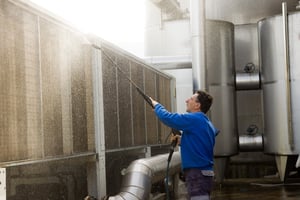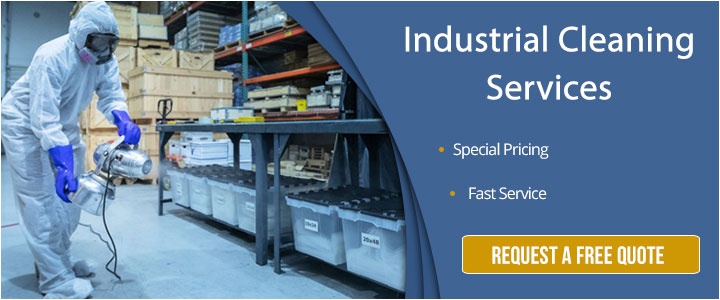Within the belly of industrial tanks lie a diverse array of liquids, each demanding meticulous care to stave off the encroachment of bacteria and fungi.
Without regular cleaning, the buildup of sludge can disrupt the potency of the contained chemicals or substances, leading to a costly conundrum for your business.
By embracing routine industrial tank cleaning services, you safeguard the functionality and longevity of these vital apparatuses. Whether you’re seeking a solution to keep your industrial tanks in top shape or your tanks are in need of cleaning before switching out the substances they will hold, here are some of the solutions you have available to you.
Industrial Cleaning Solutions For Your Tanks
There are several tank cleaning solutions available for industrial purposes, each tailored to specific needs and requirements. Some common ones include:
requirements. Some common ones include:
- Chemical Cleaning Solutions: These solutions often involve the use of specialized chemicals to break down and remove stubborn deposits, residues and contaminants from tank surfaces. Different chemicals are used based on the nature of the substances being removed and the material of the tank.
- High-Pressure Water Jetting: High-pressure water jetting involves the use of powerful streams of water to dislodge and remove dirt, scale and other deposits from tank walls and surfaces. It's particularly effective for removing solid residues and can be used in conjunction with cleaning agents for enhanced effectiveness.
- Steam Cleaning: Steam cleaning uses high-temperature steam to sanitize and clean tank interiors. The heat helps to dissolve and loosen residues, making them easier to remove. Steam cleaning is effective for removing organic matter, grease and other contaminants.
- Mechanical Agitation: Mechanical agitation methods involve the use of mechanical devices such as brushes, scrapers or rotating nozzles to physically scrub and agitate tank surfaces, dislodging and removing deposits. This method is often used in conjunction with other cleaning solutions for thorough cleaning.
- Biological Cleaning: Biological cleaning utilizes naturally occurring microorganisms or enzymes to break down organic matter and contaminants within the tank. This eco-friendly approach is often used for bioremediation of organic sludge and waste buildup.
- Manual Cleaning: In some cases, manual cleaning methods such as hand scrubbing or scraping may be necessary, especially for hard-to-reach areas or delicate tank surfaces. Manual cleaning is labor-intensive but can be effective for precision cleaning requirements.
- Abrasive Blasting: Abrasive blasting involves the use of abrasive materials such as sand, grit or beads propelled at high velocity to remove tough deposits and coatings from tank surfaces. It's effective for removing rust, paint, and heavy-scale buildup.
- Ultrasonic Cleaning: Ultrasonic cleaning utilizes high-frequency sound waves to create cavitation bubbles in cleaning solutions, which implode near the surface of tank walls, effectively loosening and removing contaminants. It's particularly useful for cleaning intricate or hard-to-reach areas.
The choice of cleaning solution depends on various factors like the type of contaminants present, the material of the tank, environmental considerations and regulatory requirements. The best tank cleaning companies will help you determine the most suitable cleaning solution for your specific tank cleaning needs.
When Industrial Cleaning Solutions Are Needed
Industrial tank cleaning services for commercial sites may be needed if your business:
- Is alerted that there may be a problem going on inside one of the tanks. You may receive these alerts through indicators that will warn you of potential problems like a slow dispenser flow, contaminated samples or the need for a new filter.
- Has an upcoming tank inspection. It’s a good idea to have your tank cleaned before an inspection.
- Is swapping the contents of a tank. A thorough cleaning before a change in product will help prevent any residual products from being left behind and damaging the new contents.
- Experiences a mechanical failure of the tank. Before a tank can be serviced, it must be emptied. Cleaning the tank ensures a safe working environment for the technician.
While these scenarios above may only occasionally occur, it’s important to make industrial tank cleaning services a routine part of your equipment maintenance plan. In general, what substances you have stored inside your tanks will dictate how often you clean the tanks.
Organizations like OSHA and top industrial cleaning companies like IDR Environmental Services can help advise you in this area. If you have industrial water tanks on your property, they should receive a thorough cleaning at least twice per year.
What The Top Tanking Cleaning Companies Offer
When choosing a tank cleaning service, it’s critical to ensure the company that you’re considering partnering with is.png?width=300&height=251&name=Subheading%20(9).png) licensed and insured to operate in your state. Yet even if the business meets these basic requirements, that doesn’t ensure that you’re getting the top value and level of expertise.
licensed and insured to operate in your state. Yet even if the business meets these basic requirements, that doesn’t ensure that you’re getting the top value and level of expertise.
The top tanking cleaning companies offer:
- Comprehensive Tank Cleaning Services: Top tank cleaning companies usually offer comprehensive cleaning services for various types of industrial tanks, including oil tanks, chemical tanks, water tanks and more. These services often include thorough cleaning of tank interiors, removal of sludge and contaminants, and inspection for any potential issues.
- Specialized Equipment and Technology: Leading tank cleaning companies invest in state-of-the-art equipment and technology to ensure efficient and effective cleaning processes. This may include high-pressure water jetting systems, steam cleaning equipment, robotic cleaning devices and specialized chemicals or cleaning agents.
- Experienced and Trained Personnel: Top tank cleaning companies employ experienced and trained personnel who are knowledgeable about industry standards, safety protocols and best practices for tank cleaning. These professionals are equipped to handle various challenges and ensure that cleaning operations are carried out safely and effectively.
- Customized Solutions: Each tank cleaning project may have unique requirements based on factors such as the type of tank, the nature of the substances stored, environmental considerations and regulatory compliance. Top tank cleaning companies offer customized solutions tailored to meet the specific needs of their clients.
- Safety and Compliance Assurance: Safety is paramount in tank cleaning operations, given the potential hazards associated with confined spaces, chemical exposure and other risks. Top tank cleaning companies prioritize safety by adhering to strict safety protocols, providing appropriate personal protective equipment (PPE) to their personnel, and ensuring compliance with relevant regulations and standards.
- Emergency Response Services: In the event of spills, leaks or other emergencies involving industrial tanks, top tank cleaning companies may offer emergency response services to contain the situation, mitigate environmental impact and prevent further damage.
- Environmental Stewardship: Many leading tank cleaning companies are committed to environmental stewardship and sustainability. They may employ eco-friendly cleaning methods, utilize biodegradable cleaning agents, and implement waste management practices to minimize environmental impact.
Finally, the key to finding a reputable industrial cleaning company also lies in researching the experiences other businesses like yours have had with that business. Through testimonials and references, you can gauge what level of customer experience and support you can expect.
By conducting thorough background checks, verifying credentials and ensuring compliance with industry regulations, you can further solidify your confidence in selecting the right industrial tank cleaning company for your needs.


Comment